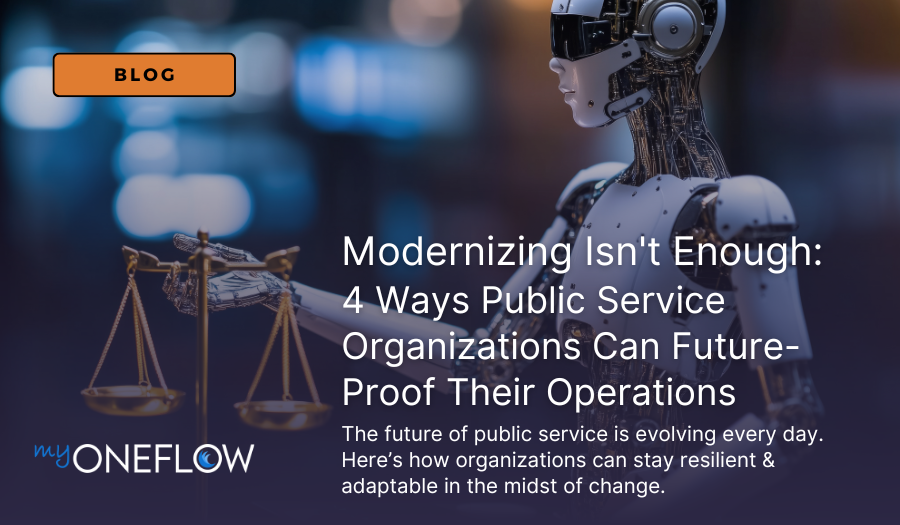Checklist: 5 Things to Look for in Your State WIOA Reporting Software
Data reporting and compliance have become increasingly complex for public service programs relying on multiple funding streams. Many organizations...
6 min read
myOneFlow Staff Feb 19, 2025 1:57:41 PM

Public service providers are navigating a turbulent environment shaped by shifting political priorities and funding directives. The current administration's alleged focus on streamlined spending and measurable outcomes has amplified the pressure on these organizations to deliver services effectively while demonstrating clear value to stakeholders. Rapidfire policy adjustments and realigned funding streams seem to be a daily occurrence, leaving many organizations grappling to meet today’s demands while preparing for tomorrow’s uncertainties.
Simply modernizing operations to keep up with the present day isn’t enough when the structure of public services is evolving so quickly. Organizations must future-proof their operations to remain resilient, adaptable, and responsive to ongoing changes. This requires the agility to adjust to new mandates and the ability to prove their impact clearly and convincingly through data.
In this article, we'll outline four practical strategies to help public service organizations position themselves for success amid this turbulent and unprecedented landscape. From diversifying funding to adopting agile technology tools, these approaches can help organizations stay impactful, relevant, and impactful—no matter what changes lie ahead.
Operating with limited funding sources - particularly if they are primarily federally sourced - can leave public service providers vulnerable to shifts in political or economic priorities. Budget cuts, policy changes, or reallocation of resources can swiftly disrupt operations if organizations don’t have a financial safety net. Diversifying funding sources helps build stability, ensuring vital programs continue to serve communities, even in times of uncertainty.
Diversifying funding sources empowers organizations to respond to evolving circumstances with greater resilience and ensures that critical support systems remain intact for the communities relying on them.
Reliance on paper-based systems and manual workflows continues to hold many public service organizations back, creating inefficiencies that undermine their ability to scale and adjust to changing demands. These systems often lead to data entry errors, delayed reporting, and bottlenecks that ultimately reduce the quality and timeliness of service delivery. Automation improves operational efficiency and allows staff to focus on more meaningful tasks that benefit from human connection. If your organization faces (or may face) staff shortages, automation can help alleviate the burden of manual workload.
Automation is a safety net during staff shortages. If staffing levels drop, well-automated workflows and digital processes can be a lifeline. With fewer hands available, automation ensures that essential data entry and compliance tasks continue without compromising accuracy or efficiency. This resilience is crucial for organizations already operating with lean teams, allowing them to maintain service quality even under challenging circumstances.
Legacy systems and inflexible platforms create significant barriers for public service organizations striving to meet evolving demands. These outdated tools often lack the adaptability needed to keep pace with shifting policies, program requirements, or participant needs—leading to inefficiencies and missed opportunities for improvement. Prioritizing agile, configurable technology empowers organizations to adjust quickly, ensuring they remain responsive and effective in an ever-changing environment.
Agile technology helps organizations pivot quickly, reducing lags in productivity or service delivery caused by outdated or overly rigid platforms. By integrating configurable technology into their operations, public service organizations can ensure they are prepared for the unexpected.
Accurate and comprehensive data collection is a non-negotiable aspect of public service operations. It serves as a foundation for justifying funding and meeting compliance requirements and as a critical tool for demonstrating an organization’s long-term impact on individuals and communities. Presenting clear and reliable outcomes to funders, stakeholders, and accountability offices helps build trust, attract investment, and secure the sustainability of critical programs.
By building a strong foundation of outcome data, public service organizations reinforce their value and secure the trust of stakeholders—a vital element in achieving long-term sustainability.
Adapting to the shifting landscape of public service requires a forward-looking approach that aligns with the pace of change. Building resilience and flexibility into operations is essential to stay responsive to political shifts, funding changes, and the ongoing demand for effective service delivery. Diversifying funding, leveraging technology wisely, and showcasing measurable impact are the foundation for sustainable service delivery in a changing world.
myOneFlow is the only configurable case management and reporting platform that is purpose-built for public service providers. Designed to meet the complex needs of this sector, it empowers organizations to respond to challenges with agility while delivering clear, actionable insights. Contact our team or explore our package offerings to learn more about myOneFlow's feature set and capabilities.
1. Why is diversifying funding sources so important for public service organizations?
Relying on a single funding source, especially federal grants, leaves organizations vulnerable to political or economic changes. Diversifying funding creates a safety net, ensuring programs can continue even if specific funding streams are reduced or eliminated. Exploring private partnerships, local grants, and revenue-generating models are effective ways to stabilize finances.
2. How can automation improve service delivery in public service settings?
Automation reduces time spent on repetitive tasks, such as data entry and report generation. It ensures accuracy, speeds up processes like participant intake and referrals, and frees staff to focus on more meaningful work. This efficiency is especially critical during staffing shortages, allowing organizations to maintain high service standards with fewer resources.
3. What makes agile or configurable technology essential for public service providers?
Flexible, configurable technology allows organizations to adapt quickly to policy changes and evolving program requirements. Platforms like MyOneFlow empower staff to customize workflows and reports in real time, eliminating delays caused by inflexible systems. This adaptability is vital for maintaining efficient service delivery during times of change.

Data reporting and compliance have become increasingly complex for public service programs relying on multiple funding streams. Many organizations...

The Workforce Innovation and Opportunity Act (WIOA) was signed into law in 2014 to replace its predecessor, the Workforce Investment Act (WIA). The...

Grant-funded public service organizations face the unique requirement of tracking both fiscal details and case management for their participants....